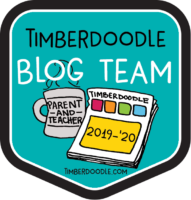French For Children by Classical Academic Press is designed so that you can teach your children French even if you are not familiar with the language. The program is appropriate for both Christian and secular homeschoolers. It is designed for children in the 4th -7th grade age range.
I am using the program with 4 students, ages 8, 10. 11, & 16.
How We Used French for Children
The program has two different suggested scheduling options. I love the flexibility this gives. If you choose to work through a chapter each week you can complete level A in one semester and move onto level B for the second half of the year.
Or you can use the two weeks per chapter schedule, which would work well for anyone who uses a 4-day a week schedule. It is also just a slower pace which will give kids who need more repetition extra time to work with the words.
We started off using the one chapter a week schedule, but by the third chapter I could tell my 8 (almost 9) & 10-year old both needed to slow down. They did not have good retention of the words from the first two chapters and I could tell some of the grammar concepts were flying over their heads.
So we slowed down and took two weeks for chapter 3. That worked out beautifully since chapter 3 also had more workbook pages to complete. Every day they went over the chants for chapters 1, 2, & 3.
I scheduled 30 minutes for French 4 days a week and 60 minutes one day a week. My youngest two take a lot longer to fill out their workbook pages and cannot handle more than one page a day.
On the other hand, my 11 and 16-year-olds, who are in 6th and 11th, respectively, can fly through all the workbook pages in one day. They translate much faster and understand grammar concepts much more easily.
One of the reasons I am using the program with a high schooler is that foreign language is not his strength. He has had Latin, but depending on which college he goes to that may not count as a Foreign Language credit. So he is studying French and by the time he finishes his senior year, he will attempt the CLEP exam to see if he can earn any college credits in French to count for whatever foreign language his degree requires.
(Of course, this is all variable from college to college, but we are trying to cover as many bases as possible.)
For younger kids (4th & 5th), I would suggest planning to use the slower schedule right off the bat. The faster schedule would be fine for most 6th and up. But remember the curriculum is just the road for you to follow and you should take the road at whatever pace your child needs.
I will probably keep flip-flopping between the fast and slow, going as fast as we can without leaving the little ones in the dust. I want to keep them learning together even though their abilities are different so they can practice their French conversation skills with each other.
French for Children is Well-Organized
The presentation of vocabulary and grammar concepts is obviously built by someone who is not only fluent in French but understands how children learn. Grammar concepts are covered early to help them get used to all those crazy endings. The video presentation follows a clear format, and this will allow you to split the video into different sections to watch on different days if you wish.
The grammar section is the longest and you will want to watch that section all on the same day.
French for Children is Pick Up & Go for Mom
The book is easy to follow. Chants covering the vocabulary and grammar (word endings) are at the front of each chapter and the track # for the CD is listed by the chant. The Teacher’s Guide is also simple and easy to follow. You won’t need much prep time to use the program. Just skim through the scheduling suggestions, put it on your calendar, and you are all set.
French for Children Will Make Your Kids Laugh
You may not think that this is important but science shows that we remember more when we are having fun. Enjoying the process helps our brain know that we are safe and the information being presented will then be routed up to our higher brain for further processing and retention…this is what we want!
Laughter matters and I was so glad to hear my kids chuckling only minutes into the first video lesson.
French for Children Uses Stories
Stories are treated in a privileged way by our brains. Stories are special and studies in cognitive science have shown that information learned through stories is remembered more easily with less repetition.
Each chapter of French for Children has a piece of a continuing story. Part of the story is told in English, with some French words sprinkled in. Kids can read the story in their workbook, but then they also can watch/listen to Dr. Joshua Kraut tell the story on the DVD and it is also on CD track for listening.
This provides a natural way for kids to review the story. Each time they hear or read it they understand the words a little more intuitively. Then the chuckles start, because, of course, the story is funny.
French for Children Uses Chants
When cognitive scientists studied different ways to present information for optimal memory retention, chants were one of the tricks on the top of the list. It is a simple, painless, and easy way to get those French words and verb forms into the memory banks.
I really love French for Children.
One of my kids was attempting to learn French last year with another popular language program. She didn’t get very far. I feel this program has taught her more in the first 3 chapters than the other one did over 6 months of study.
French for Children checks of all the boxes of a brain-friendly learning program that is also mom-friendly.


